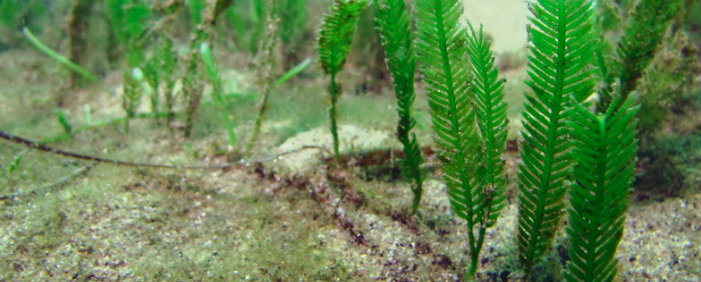
How do we react to diseases, parasites and imbalances on our plants? When we notice an anomaly in our immediate environment, we look for a way to deal with it directly. I have a headache ? I take an analgesic that treats pain … We rarely worry about the causes, as long as we manage to treat the symptoms.
This is how many gardeners react to attacks on the plants in their garden. We are ready to treat the symptoms every year on our diseased plant, even if it becomes a relentless therapeutic event. Because we are thinking about the individual or the garden. It’s a bad scale – Nature as a whole adapts, species evolve to new balances to survive the new constraints.
Yes, my ash will probably die because it is attacked by a parasite, and no, I do not have to treat it. It would be counterproductive, Nature finds its own solutions.
Who remembers the Mediterranean killer seaweed?
Do you remember the “killer seaweed” Caulerpa taxifolia that between 1984 and 2004 had grown from 1m² to 5000 ha in the Mediterranean ? This tropical alga was the plague of swimming and diving areas, capable of destroying most competing plant species and some fish.
Eight control methods – tarpaulins, brass treatments, biological control – have been developed to fight against the Threat, with limited results. And then at some point something still unexplained happened …
From 2011 the scientists found that killer algae colonies began to wither spontaneously, and in 2015, 80% of the population of Caulerpa taxifolia had disappeared …
Phylloxera epidemic in the nineteenth century.
A reminder: from 1863, Daktulosphaira vitifoliae, an American aphid piquing the roots of vines began to plague the Gard, and gradually spread to almost all French vineyards in thirty years. The damage done to the roots led to their decay and the dieback of the plant in 3 years.
In this case, the chemical treatment solutions were either inefficient or very expensive. An effective technique was even to drown the vines under a layer of water.
Resolved by grafting European grape varieties on American species that had themselves developed resistance.
Finally, the use of rootstocks from resistant vines originating from the East-American coast was the best solution, it is still used today.
Moral of the story: the species adapt over time to the aggressions , and the case of these American vines which had undergone the aggressions of Daktulosphaira vitifoliae for generations is the proof of it.
Ash trees, a serious epidemic on which we have no means of action.
Will ash trees almost disappear from our forests and gardens like elms before them? The question is currently unanswered, faced with the outbreak of chalarose from Poland – that all new parasites do not come from the tropics. This fungus produces the dieback of young shoots then whole branches, and eventually kills the tree entirely. There is no treatment – as often for trees – and the fungus is gaining new areas every year.
Fortunately, genetic diversity requires, 2 to 5% of subjects are apparently resistant to the disease. Other species will temporarily take over, until a new development opportunity opens up.
The Boxwood Borer, the hot topic.
In 2017 boxwood borer reached records of gluttony, and multiplied to the point that on some roads the motorists crossed real nebulae of these moths. Is this the end of boxwood as we know it?
This is probably the end of boxwood as a shrimp to do everything, cut to infinity and used per kilometer. But as a wild species, there is a good chance that the equilibrium will be restored, that the borer is several predators – the titsespecially begin to look at it with a greedy eye. Eventually, a kind of balance will be established, but boxwood will no longer be a species “easy to maintain”. It will pass – like the charcoals before him – in the list of species with regularly parasitized foliage and limited ornamental interest. Is that bad ? For gardening humanity yes, but for the tits it will be a blessing. To each his point of view 😉
It’s a question of time.
Asian beetles, bees, potato blight, Japanese knotweed, Phytolacca, stories of plant outbreaks and imbalances are constantly changing . Are they insoluble? Certainly not, only it takes time!
Natural rhythms have nothing to do with disruptions – our propensity to accelerate global trade serves as a booster to many problems. Formerly the speed of propagation was related to the direction of the wind or to a vector equipped with 4 or 6 legs, today we provided him with reactors .
Add to this speed of arrival of new competitors and parasites the presence of important pesticides that weaken environments, or remnants of fertilizer in soils that favor the development of greediest.
Moral of the History : the Man is often responsible for the arrival of the problem, but much more rarely of its solution . Blow to our ego 🙂
So yes, these outbreaks are abnormal, but we can not solve ourselves. Our only means of action is on a global scale, by curbing global disruptions. Nature will find new balances .